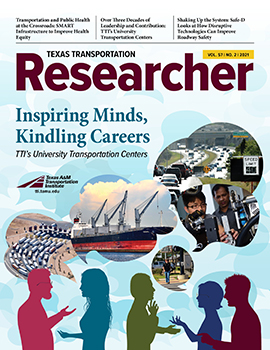
When the Texas Highway Department formed in 1917, its engineers recognized the value of university-based facilities like those at the then-Agricultural and Mechanical College of Texas (later Texas A&M University) for conducting transportation research. Fast forward to 1950 and the birth of the Texas A&M Transportation Institute (TTI) and its charter to apply Texas A&M’s broad, deep bench of academic talent to solve all manner of transportation problems.
That model of leveraging the best minds to meet the toughest transportation challenges is reflected in the U.S. Department of Transportation’s (USDOT’s) University Transportation Center (UTC) Program. Begun in 1988, the UTC Program has evolved to complement the collective research agenda of USDOT’s constituent agencies. While individual agency priorities might naturally differ, USDOT’s overall mission is the same: keep Americans safe, mobile and healthy on our nation’s transportation network — whether by land, sea or air.
Before coming to TTI, I was assistant secretary of USDOT’s Office of the Assistant Secretary for Research and Technology. I oversaw the Office of Research, Development and Technology, which operates the UTC Program. It was my honor to evaluate and select deserving universities to receive grant funding. When the program was first conceived, centers were largely awarded as congressional earmarks. In some cases, that resulted in outcomes more political than practical. Now, the program is truly competitive, with grant recipients evaluated solely on merit.
This encourages universities to partner in consortia, with each emphasizing its best talent as part of the larger team. This greater-than-the-sum-of-its-parts approach, further enhanced by diversity requirements (including allowing two-year and smaller colleges to compete), is exactly what’s needed in an era when roadside safety is as much about behaviors as barriers. Now, engineers partner with epidemiologists, psychologists, data experts and many others to study today’s complex transportation problems from multiple perspectives. We’ve learned that it takes more than a village … it takes a network of villages, guided by a national strategy and working together, to better care for everyone.
I’m proud of my role at USDOT in helping further the UTC Program’s mission. And I’m proud of my current employer, TTI, and its long history of support for that program — from former TTI Agency Director Charley Wootan’s key role in establishing the Council of University Transportation Centers, the granddaddy of the UTC Program, to the consistently excellent Institute proposals that won former and current UTCs dedicated to resolving our nation’s most pressing transportation issues. There’s never been a better time for the UTC Program’s continued vision, leadership and support. Take my word for it.

